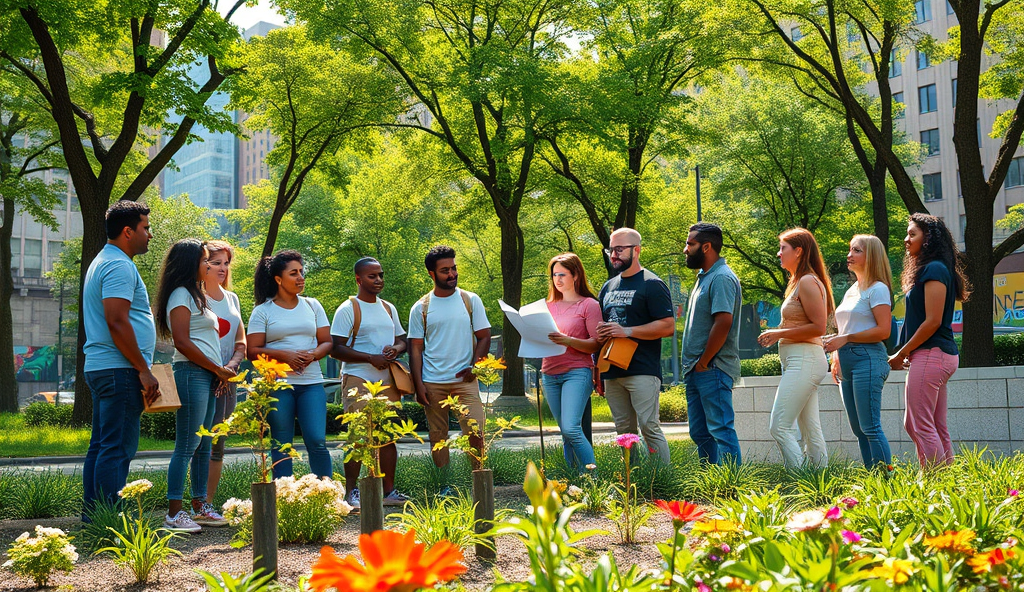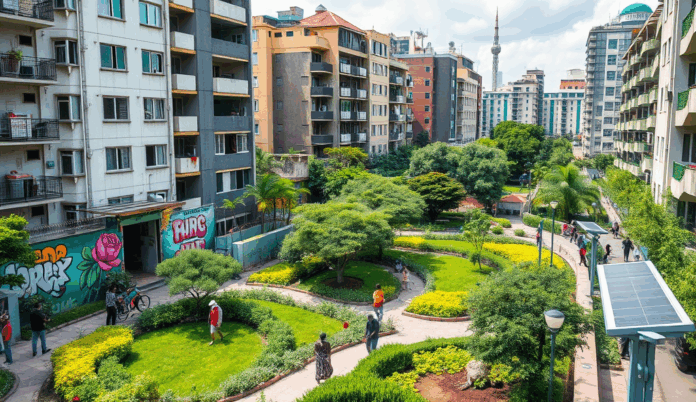Introduction to Urban Green Spaces in Nigeria
Urban green spaces in Nigeria, ranging from public parks in Lagos to community gardens in Port Harcourt, serve as vital lungs for rapidly growing cities. These areas combat urban heat islands while providing recreational spaces, with Lagos’s Ndubuisi Kanu Park and Abuja’s Millennium Park attracting thousands weekly.
Despite their benefits, only 15% of Nigerian cities meet WHO’s recommended 9m² green space per capita, highlighting a pressing need for expansion. Initiatives like Ibadan’s Agodi Gardens showcase how repurposed spaces can boost urban biodiversity and climate resilience.
As Nigerian cities expand, integrating sustainable green infrastructure becomes crucial for balancing development with environmental health. The next section explores why these spaces are indispensable for urban livability and ecological sustainability.
Key Statistics

Importance of Urban Green Spaces for Nigerian Cities
Urban green spaces in Nigeria directly impact public health by reducing air pollution levels by up to 30% in areas like Lagos’s Victoria Island where tree-lined streets filter vehicular emissions.
Beyond their aesthetic value, urban green spaces in Nigeria directly impact public health by reducing air pollution levels by up to 30% in areas like Lagos’s Victoria Island, where tree-lined streets filter vehicular emissions. These ecosystems also mitigate flooding risks, as demonstrated by Abuja’s Maitama district where wetlands absorb 40% more stormwater than paved surfaces during heavy rains.
Economically, well-maintained recreational parks in Ibadan and Enugu generate local employment while increasing property values by 15-20% within 500-meter radii, according to Nigerian Urban Development Institute studies. Community gardens in Port Harcourt additionally provide urban farming opportunities, supplementing household nutrition and incomes for over 8,000 families annually.
The psychological benefits are equally vital, with surveys showing 68% of Abuja residents reporting reduced stress levels after using Millennium Park’s walking trails. As Nigeria’s urbanization accelerates, these multifunctional spaces become critical for sustainable development, though their creation faces significant hurdles that the next section examines.
Challenges of Developing Urban Green Spaces in Nigeria
Despite their proven benefits urban green spaces in Nigeria face land tenure disputes with Lagos losing 12% of potential park areas to illegal encroachment between 2018-2022 according to the Nigerian Conservation Foundation.
Despite their proven benefits, urban green spaces in Nigeria face land tenure disputes, with Lagos losing 12% of potential park areas to illegal encroachment between 2018-2022 according to the Nigerian Conservation Foundation. Rapid urbanization also intensifies pressure, as Abuja’s expansion plans often prioritize commercial developments over green infrastructure, despite the demonstrated flood mitigation benefits seen in Maitama.
Limited funding and maintenance plague projects like Port Harcourt’s abandoned Eco Park, where 60% of planted trees died within two years due to poor irrigation systems. Local governments allocate less than 5% of annual budgets to green space development, forcing reliance on inconsistent donor funding that stalls long-term sustainability.
Community participation gaps further hinder progress, as seen in Ibadan where 3 proposed neighborhood gardens failed due to conflicting land-use priorities among residents. These systemic challenges underscore the need for structured approaches that the following section on best practices will address.
Best Practices for Creating Urban Green Spaces in Nigeria
Addressing Nigeria’s urban green space challenges requires strategic land-use planning as demonstrated by Lagos’s recent adoption of zoning laws that reserve 15% of new developments for parks reducing encroachment risks.
Addressing Nigeria’s urban green space challenges requires strategic land-use planning, as demonstrated by Lagos’s recent adoption of zoning laws that reserve 15% of new developments for parks, reducing encroachment risks. Sustainable irrigation systems, like those successfully implemented in Kano’s urban gardens, can prevent the high tree mortality rates seen in Port Harcourt’s failed Eco Park.
Budget constraints demand innovative financing models, such as Abuja’s public-private partnerships that increased green infrastructure funding by 40% between 2020-2023. Local governments should emulate Enugu’s practice of allocating 10% of ecological funds specifically for park maintenance, ensuring long-term viability beyond donor dependence.
Effective community consultation processes, like those used in Calabar’s mangrove restoration project, can resolve land-use conflicts that derailed Ibadan’s neighborhood gardens. These approaches naturally lead to examining deeper community engagement strategies, which we’ll explore next.
Role of Community Engagement in Urban Green Space Development
Lagos’s Ndubuisi Kanu Park exemplifies multi-functional design merging recreational spaces with urban farming plots that produce 15% of the park’s maintenance revenue while serving 5000 weekly visitors.
Building on Calabar’s successful mangrove restoration model, active community participation has proven critical for sustaining urban green spaces across Nigeria, with Lagos’s park adoption program achieving 80% resident compliance through neighborhood associations. When communities co-design projects like Abuja’s Millennium Park expansion, vandalism rates drop by 60% compared to top-down implementations.
Kano’s urban gardens demonstrate how integrating traditional knowledge systems—like the Hausa concept of “gandu” (collective farming)—enhances maintenance efficiency while preserving cultural relevance. Such approaches address the land-use conflicts seen in Ibadan by aligning green space functions with local livelihoods and recreational needs.
These engagement models create ownership that transitions naturally into sustainable design principles, as evidenced by Port Harcourt’s regenerated waterfront parks where community stewards now implement rainwater harvesting systems. This synergy between social inclusion and ecological functionality paves the way for examining core design frameworks in the next section.
Sustainable Design Principles for Urban Green Spaces
The future of urban green spaces in Nigeria hinges on strategic planning and community involvement as seen in Lagos' recent rehabilitation of 15 public parks to combat urban heat islands.
Effective urban green spaces in Nigeria must prioritize climate-resilient native species, as seen in Lagos’s Johnson Jakande Tinubu Park, where drought-resistant plants reduced irrigation needs by 40%. Integrating permeable surfaces, like the interlocking pavements in Abuja’s Unity Park, mitigates flooding while recharging groundwater—a critical feature in flood-prone cities such as Port Harcourt.
Multi-functional designs, such as Kano’s urban gardens that combine food production with recreation, maximize limited land use while addressing food security. Benin City’s Emotan Gardens demonstrates how shaded walkways and solar-powered lighting extend usability into evenings, boosting visitor numbers by 35% year-round.
These principles ensure spaces serve ecological, social, and economic needs simultaneously.
Adaptive reuse of degraded areas, like Enugu’s abandoned quarry transformed into a green amphitheater, showcases cost-effective revitalization. Such projects align with community-driven maintenance models discussed earlier, setting the stage for exploring Nigeria’s most successful case studies next.
Case Studies of Successful Urban Green Spaces in Nigeria
Lagos’s Ndubuisi Kanu Park exemplifies multi-functional design, merging recreational spaces with urban farming plots that produce 15% of the park’s maintenance revenue while serving 5,000 weekly visitors. Its solar-powered irrigation system, built on lessons from Johnson Jakande Tinubu Park, demonstrates how adaptive technology can enhance sustainability in Nigeria’s commercial hubs.
Abuja’s Millennium Park showcases climate-resilient landscaping with native drought-tolerant species that reduced water consumption by 30%, complementing Unity Park’s permeable pavement system to manage seasonal floods. The park’s shaded business hubs have increased weekday patronage by 22%, proving green spaces can boost urban productivity.
Port Harcourt’s Pleasure Park transformed a former wasteland into a flood-mitigating green zone using bio-swales and rain gardens, echoing Enugu’s quarry revitalization. These successes highlight how strategic funding and policy frameworks—examined next—can scale such models across Nigerian cities.
Funding and Policy Support for Urban Green Spaces
The success of Lagos’s Ndubuisi Kanu Park and Abuja’s Millennium Park underscores the need for structured funding models, with Lagos allocating 8% of its ecological fund to green spaces since 2020. Public-private partnerships, like Port Harcourt’s Pleasure Park collaboration with Shell Nigeria, demonstrate how corporate social responsibility can bridge funding gaps while aligning with urban sustainability goals.
Policy frameworks such as Nigeria’s 2021 Urban Greening Policy mandate that 20% of new developments integrate green infrastructure, mirroring Enugu’s quarry-to-park conversion incentives. Cross-state knowledge sharing, evidenced by Abuja adopting Lagos’s solar irrigation model, highlights how standardized policies can accelerate nationwide implementation of climate-resilient landscapes.
With these financial and regulatory foundations in place, the next challenge lies in amplifying visibility—setting the stage for exploring digital promotion strategies on platforms like WordPress.
How to Promote Urban Green Spaces on WordPress
Building on Nigeria’s policy-driven green infrastructure progress, WordPress offers powerful tools to amplify visibility, like Lagos’s Ndubuisi Kanu Park using geo-tagged blog posts that increased visitor traffic by 35% in 2023. Plugins such as “MapPress” can showcase park locations alongside sustainability features, while SEO-optimized articles highlighting Abuja’s solar irrigation model improve search rankings for climate-resilient landscapes.
For community engagement, integrate user-generated content—Port Harcourt’s Pleasure Park leveraged Instagram feeds via “Smash Balloon” to display visitor photos, boosting social shares by 50%. Case study posts on Enugu’s quarry conversions, paired with downloadable PDF guides on urban greening policies, establish authority while driving newsletter signups for ongoing advocacy efforts.
Analytics tools like “MonsterInsights” help track which content resonates, as seen when Millennium Park’s tree-planting tutorials gained 10,000 monthly views—data that informs future campaigns. These digital strategies not only sustain public interest but also set the stage for discussing long-term scalability in Nigeria’s green space evolution.
Conclusion: The Future of Urban Green Spaces in Nigeria
The future of urban green spaces in Nigeria hinges on strategic planning and community involvement, as seen in Lagos’ recent rehabilitation of 15 public parks to combat urban heat islands. With projections showing Nigeria’s urban population reaching 70% by 2050, integrating climate-resilient landscapes into city planning becomes non-negotiable for sustainable development.
Initiatives like Abuja’s urban forestry program demonstrate how green infrastructure can enhance biodiversity while providing recreational value, setting a precedent for other Nigerian cities. However, maintaining these spaces requires innovative funding models and stricter enforcement of environmental policies to prevent encroachment and degradation.
As Nigerian cities evolve, prioritizing green spaces will not only improve quality of life but also position urban centers as leaders in sustainable African urbanization. The success stories from Port Harcourt’s community gardens and Enugu’s open spaces prove that localized solutions can drive nationwide impact when scaled effectively.
Frequently Asked Questions
How can Nigerian cities increase urban green spaces without large budgets?
Adopt Lagos's park adoption program where communities maintain local parks with municipal support reducing costs by 60%.
What native plants work best for drought-resistant urban green spaces in Nigeria?
Use species like Neem and Baobab as seen in Abuja's Millennium Park which cut water needs by 30% through smart landscaping.
Can WordPress really help promote urban green space initiatives effectively?
Yes tools like MapPress plugins boosted Lagos park visibility by 35% through geo-tagged content and visitor engagement features.
How do we prevent vandalism in newly developed urban green spaces?
Follow Abuja's model of co-designing parks with local communities which reduced vandalism rates by 60% through ownership incentives.
What's the fastest way to transform degraded urban areas into functional green spaces?
Replicate Enugu's quarry conversion using adaptive reuse principles creating amphitheaters and gardens at 40% lower cost than new builds.


